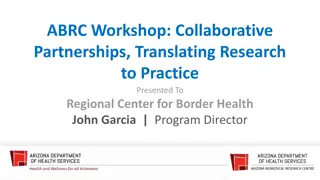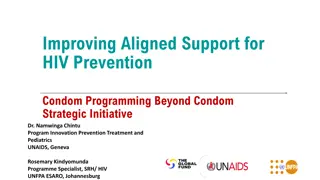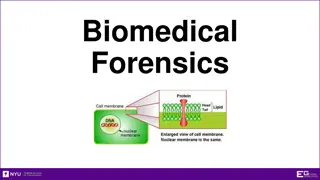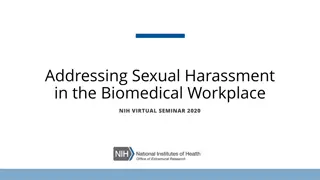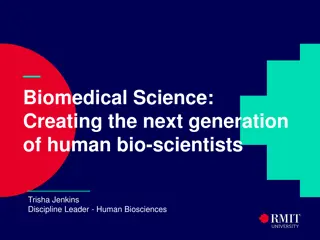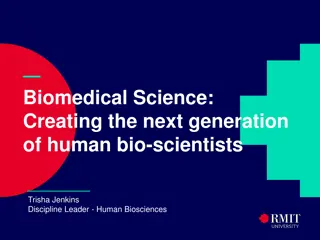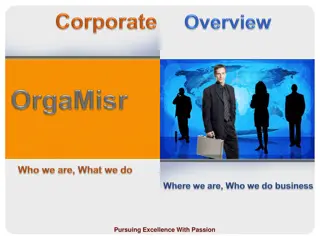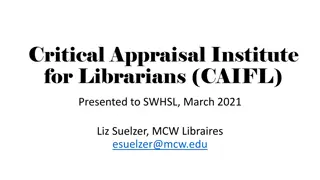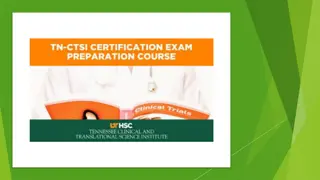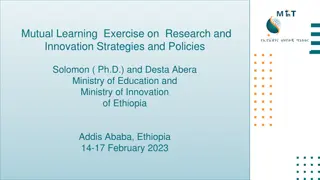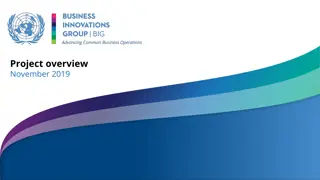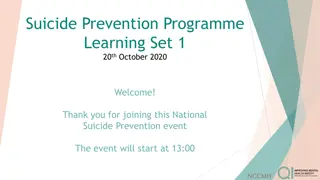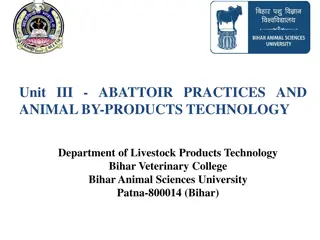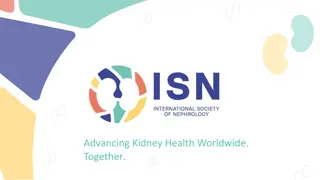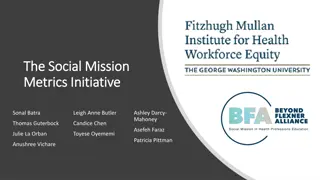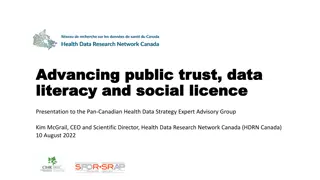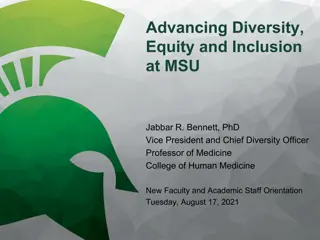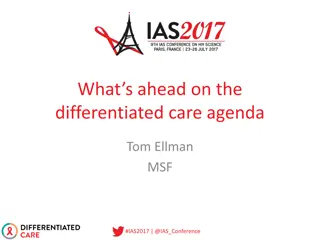Advancing Biomedical Prevention Products: PMM Country Landscaping Analysis
PMM is progressing on planning for introducing CAB-LA for biomedical prevention, aiming to address challenges with oral PrEP and accelerate impact. The report discusses findings, recommendations, and next steps for Malawi and Zimbabwe, emphasizing the importance of intentional coordination, regulatory approval, and operationalizing country landscaping recommendations. The need for effective planning and coordination is highlighted as the HIV prevention pipeline grows and diversifies in the coming years.
Download Presentation

Please find below an Image/Link to download the presentation.
The content on the website is provided AS IS for your information and personal use only. It may not be sold, licensed, or shared on other websites without obtaining consent from the author. Download presentation by click this link. If you encounter any issues during the download, it is possible that the publisher has removed the file from their server.
E N D
Presentation Transcript
PMM Country Landscaping Analysis Overview Progress Update and Next Steps September 2020
Contents 1. Planning for CAB-LA Introduction 2. Methodology Overview 3. Findings & Recommendations for Early Implementation Project Focus a. Malawi b. Zimbabwe 4. Translating & Operationalizing Country Landscaping Recommendations 2
PMM is advancing planning for future biomedical prevention product introductions, with a focus on CAB-LA, to avoid oral PrEP challenges and reduce time to impact Research-to-Rollout Timeline Oral PrEP early adopters PMM aims to expand the product portfolio and shorten the time between regulatory approval and product uptake Oral PrEP later adopters DPV ring CAB-LA Other Pipeline Products While there are continued opportunities to achieve impact with interventions like oral PrEP, experience from family planning delivery suggests we can improve uptake and use by expanding the product portfolio. PMM draws lessons from current HIV prevention interventions to inform the development and delivery of next-generation products. Through innovative approaches, PMM is improving coordination of post-trial access and rollout to ensure these more optimal products reach those in need as quickly as possible. 3
Intentional coordination will continue to be critical to facilitate rapid learning and achieve greater impact Regulatory Approval & Normative Guidance Delivery / Supply Chain Individual Uptake & Continued Use Research Planning & Budgeting ViiV Global C I V I L HPTN HPTN WHO BioPIC (TA, framework, coordination) SA NDOH Country Landscapes S O C I E T Y NASCOP Regional/ National Zim MOHCC BPS/Malawi Funding To expand with BioPIC donor engagement NIAID NIAID BMGF PEPFAR 4 Global Fund
The need for intentional coordination and planning will increase in the years ahead, as the HIV prevention pipeline continues to grow and diversify | 2020 | 2021 | 2022 | 2023 | 2024 Possible HPTN 084 results Possible FDA Submission Possible regulatory approval & early introduction for CAB-LA Possible regulatory approval & early introduction for DPV ring Possible regulatory approval & early intro of Dual Px Pill F/TAF efficacy trial in women Monthly oral PrEP (Islatravir) Phase II trial Monthly oral PrEP (Islatravir) efficacy trials 5
Successful product introduction will involve well-designed, phased implementation projects in priority countries to answer key demand and supply-side questions and inform planning for broader scale up PMM has undertaken landscaping in Malawi and Zimbabwe to inform design of early implementation projects. Using a comment framework, this approach will yield standardized outputs and establish a precedent for similar assessments going forward both for CAB-LA and other pipeline products. The outcomes of this analysis will inform early implementation planning and prioritization including: How and where can prevention products be effectively delivered to target populations? Where should early implementation projects focus? What pending questions should demonstration projects aim to answer to inform broader, more effective implementation? Who are the target populations? How can target populations be supported to take up a product using attract, engage, and enable interfaces? 6
Contents 1. Background 2. Methodology Overview 3. Findings & Recommendations for Early Implementation Project Focus a. Malawi b. Zimbabwe 4. Translating & Operationalizing Country Landscaping Recommendations 7
PMM used quantitative and qualitative methods to identify sub-national geographies, target populations, delivery channels, and prevention networks to prioritize in early introduction activities for CAB-LA Where? Who? PMM first identified target populations through: 1. Quantitative analysis comparing incidence across sub-populations 2. Qualitative review of government strategic documents, seminal studies, and in-country programming to fill gaps in data In collaboration with BMGF, PMM identified priority sub-national geographies based on three filters: High need geographies based on incidence Geographies with existing programming and/or infrastructure to support sustainability of future investments Geographies documented as key population-specific priorities PMM then conducted in-depth reviews on barriers and enablers for AGYW, FSW, and MSM along the product adoption pathway to identify optimal attract, engage, and enable (AE&E) channels Which Channels? How? Because no single UPI or AE&E will be best suited to provide services to all populations, PMM recommends developing prevention networks to effectively meet the needs of target populations over time: PMM mapped existing and potential user-provider interfaces (UPIs) across target population groups, documenting readiness to deliver CAB-LA and effectiveness in reaching target populations: Private Public End-User Service Delivery Hub Attract, Engage, Enable Entry Points Channels Health Service Community- Based UPI Community- Based UPI Facility-Based UPI Facility-Based UPI AGYW MSM FSW Females, 24-35 PBFW *For full methodologies on each section, see Phase I, Phase II, and Phase III decks 8
Contents 1. Background 2. Methodology Overview 3. Findings & Recommendations for Early Implementation Project Focus a. Malawi b. Zimbabwe 4. Translating & Operationalizing Country Landscaping Recommendations 9
Comprehensive delivery networks of UPIs and AE&Es should be assembled to best meet individual and population needs over time HIV Prevention User Journey Network Attract, Engage, Enable Interfaces AE&E Channels E.g.: mass media, girls clubs, peer educators, virtual support platforms Entry Point UPIs Will serve as service delivery entry points, providing information and/or part of the CAB-LA delivery cascade (e.g. counseling, testing) and linking clients to delivery hubs. AE&E Channels Will provide information to link clients to prevention services and/or continuation support. Service Delivery Hub User-Provider Interfaces Will be UPIs that are fully equipped to deliver CAB-LA. Service Delivery Hubs Recommended service delivery channel for CAB-LA However, client pathways and UPI roles within a given network are expected to be adaptable and can evolve over time: Entry Point UPIs Health system entry points that play a supportive role, linking clients to a service delivery hub An entry point UPI that is not initially capacitated to deliver CAB-LA may evolve over time to become a fully functioning hub. In some cases, a fully equipped hub may rather serve as an entry point, linking a user to service delivery at a more acceptable or accessible hub. Client pathways are unlikely to be linear and will evolve over time, depending on client preferences and needs along the product adoption pathway 10
Attract, engage, and enable channels, will shape client experiences of and navigation through prevention networks, providing support through all phases of product adoption from awareness to adherence AWARENESS EVALUATION UPTAKE ADHERENCE Mass media messaging Meet them where Continue to reach out to Virtual support through through radio, T V , social they are: hotspots, providers to educate hotspots, bars, socialmedia, bars, to let them know about empathetic care data gathering to media advertising to the options and normalize prevention. programs. Appropriate mix by region Deep dive happens in Improve, supplement or and privacy small groups Small groups to educate on prevention array within a relationship and empowermentfocus. Existing girls club infrastructure Look up to: Influencers by segment, aspirational near peers prompts, reminders and ALL GROUPS for KPand help KP prepare. intervene. Investigate comfort level Optimal attract, engage, and enable (AE&E) channels will vary based on population groups and where clients are on their product adoption journey. concerns replace Public, private and SRH- focused clinics. Investigate demedicalized support and build options Small groups to provide regular in person social AGYW agency. FSW outreach affiliated clinics, mobile clinics. Validate demedicalized maintaining prevention in options, especially pharmacies. Small groups to educate on prevention array with an explicit health focus. Small groups to provide practical tips for However, some approaches or strategies will be broadly applicable across population groups and product adoption phases. FSW Existing FSW outreach programs Look up to: Big sister, littlesister challenging situations. Small groups to help with navigating a hostile system, reinforce Small groups to introduce prevention array as part of living afulfilling life. Public, private and men s clinics, LGBTQ- centered options. Investigate demedicalized prevention as important options MSM Existing LGBTQ communityspaces Look up to: Community role models,Influencers for a man. 11
Contents 1. Background 2. Methodology Overview 3. Findings & Recommendations for Early Implementation Project Focus a. Malawi b. Zimbabwe 4. Translating & Operationalizing Country Landscaping Recommendations 12
In Malawi, early CAB-LA implementation should leverage STI and FP clinics and drop-in centers, generating broad awareness with mass media and employing targeted engagement to reach priority populations Recommended User-Provider Interfaces Sub-National Priority Geographies: Proposed service delivery hubs : STI clinics (public facilities) FP clinics (public facilities) 3 Blantyre, South West Zone 1 Private clinics Drop-in centers Lilongwe, Central West Zone 2 2 Key supportive spokes : ANC/PNC clinics Under-5 clinics Mobile clinics Club outreach services KP hotspot pop-up services School outreach services 1 Mzuzu, Mzimba, North Zone 3 Target Populations* Key Attract, Engage, and Enable Channels Females, 24-35 Awareness Mass media messaging through radio, TV, social media to normalize prevention Population-specific small groups and targeted outreach Evaluation Population- specific small groups and targeted outreach through hotspots, bars, social media Uptake Public and private clinics Outreach or population- specific channels for groups who cannot or do not access public facilities Adherence Virtual support through prompts and reminders Population- specific small groups AGYW FSW MSM Clients of FSW Truck Drivers PBFW TGP Border Traders Female Vendors Barriers and enablers analyzed Quantifiable *For full end-user analysis on AGYW, FSW, and MSM, see Phase II deck 13
Government partners emphasized the importance of prioritizing introduction in all three regions in Malawi, ensuring generation of diverse evidence that can be translated into learnings across and beyond the country Blantyre 1 South West Zone Lilongwe Central West Zone Mzuzu City Mzimba, North Zone 2 3 Higher district-level HIV prevalence among MSM than national MSM avg Highest district-level HIV incidence Urban-rural composition Highest incidence in the Northern Region, but lower incidence in surrounding rural area Epidemic 3 Trial site for HPTN 084 DREAMS district with existing infrastructure PEPFAR KP programming Oral PrEP demo projects PEPFAR programming for KPs through FHI and Jhpiego & programs for PBFW and SDC through EGPAF Programming* Trial site for HPTN 084 Oral PrEP demo projects PEPFAR KP programming & programs for PBFW and SDCs 2 1 BPS focusing on HSS with dedicated district Px Coordinator to drive integrated Px strategy Shared Tx/Px Coordinator to drive program strategy and linkage Siloed program specific Px coordinator to support integrated programming and Px linkages Systems *These three geographies align with districts with highest PrEP targets in COP2020; for full district profiles, see Phase I deck 14
While networks across districts have similarities, in Blantyre, drop-in centers may be optimal hubs for a community-based prevention network, as they already provide services to many populations Network Overview & Analysis Community based UPI network with Drop-In Center as hub Management Support: District Health Office (DHO) provide support to the Drop-In Centers, which includes staffing some centers. Supply Chain System: Drop-In Center/DREAMS sites supported by partners involved in direct service delivery procure their own HIV commodities. Data system & Flow: Drop-In Center/DREAMS sites attached to a Government facility in the catchment area for reporting End-User Go Girls Clubs Virtual Support Mass Media Attract, Engage, Enable Channels Peer Mobilisers School Outreach Small Groups STI Clinic FP Clinics Mobile Clinics ANC/PNC End-User Considerations Health Service Entry Points HTS Clinics ART Clinics Under 5 Clinics AGYW generally prefer convenient user-provider interfaces where they won t be seen accessing HIV- related services to minimize stigma. Pop-Up Sites at KP Hot spots FSW often prefer to access services in a one-stop shop model with operating hours that are convenient to their working hours. Drop-In Center (incl. DREAMS sites for AGYW) MSM may perceive stigma in public facilities and prefer more readily accessible sites where services are perceived to be confidential and peer-driven. Service Delivery Hub 15
STI and Family Planning clinics may also be optimal public sector hubs in Blantyre, given the overlapping risk factors of clients accessing these services Network Overview & Analysis Public facility-based network with STI and/or FP clinics as the hub End-User Management Support: Facility-in-charge leads the service delivery operations with backstop support from the District Health Office. Go Girls Clubs Virtual Support Mass Media Supply Chain System: commodities are procured and distributed through the MOH supply chain systems for HIV commodities Attract, Engage, Enable Channels Peer Mobilisers School Outreach Data system & Flow: Data flows through the national DHIS system. For mobile/ outreach services, data is reported to the main facility supporting the service. End-User Considerations AGYW generally prefer to receive services where they already obtain care. They will also have familiarity with injectables at an FP clinics. However, public facilities may feel less private and more stigmatizing than Drop-In Centers for AGYW. FSW will likely prefer to receive services where they already obtain care, so FP and STI clinics will provide an optimal service delivery point for FSW already accessing these services, but both FSW and MSM are likely to perceive stigma at public facilities. Small Groups Mobile Clinics HTS Clinics ART Clinics Drop-In Centers Under 5 Clinics ANC/PNC Health Service Entry Points Pop-Up Sites at KP Hot spots STI/FP Clinic MSM who do not self-identify are unlikely to access specialized care, so public facilities will be an important service delivery point if hours are convenient. Service Delivery Hub 16
Contents 1. Background 2. Methodology Overview 3. Findings & Recommendations for Early Demonstration Project Focus a. Malawi b. Zimbabwe 4. Translating & Operationalizing Country Landscaping Recommendations 17
In Zimbabwe, early CAB-LA implementation should leverage VCT clinics, and partner-led satellite and mobile clinics, strengthening communication platforms for awareness and targeted engagement for priority populations Sub-National Priority Geographies: Beitbridge, Mat. South 2 2 Recommended User-Provider Interfaces Proposed service delivery hubs : VCT clinics (public facilities) Satellite clinics 1 Private clinics (pharmacy) Mobile clinics 1 Chitungwiza, Harare 2 Key supportive spokes : ANC/PNC clinics Under-5 clinics FP clinics 4 Youth friendly facility Pop up clinics School outreach services Gwanda, Mat. South 3 3 1 Tsholotsho, Mat. North 4 Target Populations Recommended User-Provider Interfaces Females, 24-35 MSM FSW AGYW Awareness Mass media messaging through radio, TV, social media to normalize prevention Targeted roadshows Evaluation Population- specific small groups and targeted outreach through community dialogue and social clubs Uptake Public and private clinics Outreach or population-specific channels for groups who cannot or do not access public facilities Adherence Virtual support through prompts and reminders. Community support through clubs and groups led by CHWs Clients of FSW PBFW Prisoners TWG People who use drugs Trans male/ female SW Barriers and enablers analyzed *For full end-user analysis on AGYW, FSW, and MSM, see Phase II deck People with disabilities Quantifiable 18
District prioritization discussions are ongoing with government partners to ensure generation of diverse evidence that can be translated into learnings across and beyond the country Beitbridge Mat South Chitungwiza Harare Tsholotsho Mat North Gwanda Mat South 1 2 4 3 Border town with high population of AGYW, FSW and their clients Second highest district-level HIV incidence Peri-urban with mining industry Rural district with all epi indicators in top 10. 5th highest HIV incidence Highest district- level HIV incidence Urban district Epidemic Comprehensive Px/SRH services for AGYW/KP Trial site for ASPIRE, MTN-032,HPTN 081, HVTN 107 Existing structures from trials and demo projects PEPFAR oral PrEP expansion district for AGYW, FSW Trial Site SAPPH-IRe HIV Px PEPFAR oral PrEP expansion district Trial Site for SAPPH-IRe HIV Px Oral PrEP pilot district Leverage infrastructure from pilots PEPFAR oral PrEP expansion district Trial Site for SAPPH-IRe HIV Px Programming for BMGF-PSI is 3 of 7 districts in province Leverage BMGF- PSI investment in Mat South Systems BMGF-STRIDE supports Provincial Officers to coordinate integrated Px program implementation in all provinces 19 For full district profiles, see Phase I deck
In Zimbabwe, VCT and Family Planning clinics could serve as potential hubs for service delivery within the public system due to their existing capacity and reach Network Overview & Analysis End-User Public facility-based network with VCT and/or FP clinics as the hub Management Support: District Medical Officer (DMO) serves as overall decision maker with support from HIV focal person (could be district nursing officer (DNO) and district health promotion officer (DHPO). Supply Chain System: commodities are procured and distributed through the MOH supply chain systems for HIV commodities. Data system & Flow: Data flows through the national DHIS system, with management from a district health information officer (DHIO) who coordinates data collection and submission to province. End-User Considerations AGYW generally prefer to receive services where they already obtain care. They will also have familiarity with injectables at an FP clinics. However, public facilities may feel less private and more stigmatizing than Drop-In Centers for AGYW. Like AGYW, FSW will likely prefer to receive services where they already obtain care, so FP and STI clinics will provide an optimal service delivery point for FSW already accessing these services but both FSW and MSM are likely to perceive stigma at public facilities. Virtual Support Platforms Mass Media Attract, Engage, Enable Channels Peer Mobilisers School Outreach Small Groups/Clubs STI Clinics Mobile Clinics ART Clinics Health Service Entry Points VIAC Under 5 Clinics ANC/PNC KP/Youth-Friendly Sites VCT/FP Clinic MSM who do not self-identify are unlikely to access specialized care, so public facilities will be an important service delivery point if hours are convenient. Service Delivery Hub 20
While they will be important UPIs across the country, mobile clinics are particularly appealing as service delivery hubs in Beitbridge, targeting high mobility clients in the border town Network Overview & Analysis Community based network with mobile clinics as the hubs Management Support: District Medical Officer (DMO) serves as overall decision maker with support from HIV focal person (could be district nursing officer (DNO) and district health promotion officer (DHPO). Supply Chain System: commodities are procured and distributed through the MOH supply chain systems for HIV commodities. Data system & Flow: Data flows through the national DHIS system, with management from a district health information officer (DHIO) who coordinates data collection and submission to province. End-User Virtual Support Platforms Mass Media Attract, Engage, Enable Channels Peer Mobilisers School Outreach Small Groups/Clubs ART Clinics Satellite Clinics STI Clinics VIAC Under 5 Clinics ANC/PNC Health Service Entry Points End-User Considerations Studies have demonstrated that AGYW, FSW, and MSM prefer the convenience and discretion provided by mobile clinics. However, the lack of consistency of when the clinic will be at a given site may present a barrier. Special considerations for location and operating hours will be needed to optimize delivery through mobile clinics for different target populations (e.g. proximity to a school for in-school AGYW or a KP hotspot during convenient hours for MSM and/or FSW). VCT Clinics FP Clinics KP/Youth-Friendly Sites Mobile Clinics Service Delivery Hub 21
Similarly, satellite clinics are key delivery points across Zimbabwe, but may serve as particularly important hubs in Gwanda and Chitungwiza, due to their strong existing integrated HIV programming Network Overview & Analysis End-User Community based network with satellite clinics as the hub Management Support: District Medical Officer (DMO) serves as overall decision maker with support from HIV focal person (could be district nursing officer (DNO) and district health promotion officer (DHPO). Supply Chain System: commodities are procured and distributed through the MOH supply chain systems for HIV commodities. Data system & Flow: Data flows through the national DHIS system, with management from a district health information officer (DHIO) who coordinates data collection and submission to province. End-User Considerations AGYW generally prefer convenient user-provider interfaces where they won t be seen accessing HIV-related services to minimize stigma. FSW often prefer to access services in a one stop shop model with operating hours that are convenient to their working hours. MSM may perceive stigma in public facilities and prefer more readily accessible sites where services are perceived to be confidential and peer-driven. However, government policies around MSM and FSW serve as a major barrier to accessing Virtual Support Platforms Mass Media Attract, Engage, Enable Channels Peer Mobilisers School Outreach Small Groups/Clubs ART Clinics Mobile Clinics STI Clinics VIAC Under 5 Clinics ANC/PNC Health Service Entry Points VCT Clinics FP Clinics KP/Youth-Friendly Sites Satellite Clinics Service Delivery Hub any services perceived to be population-specific. 22
Contents 1. Background 2. Methodology Overview 3. Findings & Recommendations for Early Demonstration Project Focus a. Malawi b. Zimbabwe 4. Translating & Operationalizing Country Landscaping Recommendations 23
As part of the ongoing landscaping, PMM is outlining items required for operationalization of recommended models/geographies (1/2) PMM did consider feasibility when identifying UPIs. However, even relatively feasible delivery points will require system and policy adjustments to optimize CAB-LA delivery. Moreover, feasibility does not always align with end-user preferences. Sample Questions for Pilot Design Landscaping Focal Area What demand generation/AEE channels have broadest reach and are associated with higher uptake? How do these compare across geographies, populations and demographic factors? What messaging most resonates with and persuades users to initiate CAB-LA & HIV px generally? Demand Generation What are existing service uptake and continuation rates across different delivery channels, disaggregated by location, population and demographic factors? Which delivery channels are most cost-effective and what adaptations are required to prime them to offer CAB-LA to the health system? What counseling strategies and follow-up systems are most effective in supporting CAB-LA users to continue and to restart if they stop injections? Service Delivery What different cadres can deliver CAB-LA and how does this need to be adapted by facility and channel type? What training approaches are most effective in supporting providers to offer CAB-LA alongside an array of HIV prevention options? What counseling strategies, tools and job aids are most effective at driving initiations and most used/preferred by providers? Health Workforce 24
As part of the ongoing landscaping, PMM is outlining items required for operationalization of recommended models/geographies (2/2) Landscaping Focal Area Sample Questions for Pilot Design What are the optimal mechanisms at the national and sub-national level for coordinating CAB-L A introduction, what stakeholders need to be involved, from which sectors and how can these be sustained? What evidence do stakeholders need to support introduction of a new product? Leadership & Governance How would supply chain systems need to be changed or adapted to accommodate new delivery channels for CAB-LA? Supply Chain Financing What are the likely costs related to operationalizing interfaces? What changes need to be made to integrate CAB-LA existing M&E tools, registers and reporting? What adaptations need to be made to the pharmacovigilance systems for ongoing safety and resistance monitoring? Information Systems 25
Completed landscaping analyses will help define specific research questions and other investment priorities Implementation Projects Near-Term Priorities Through Q1 2021 Design to begin in 2021 to ensure readiness upon CAB-LA approval Based on size and scope of investment, early implementation projects can answer key questions to support successful CAB-LA introduction: What sub-groups are most likely to initiate CAB-LA at a given UPI? What AE&E channels are most effective at supporting product uptake and use among target populations? How do end-user preferences, product use patterns, and engagement with service delivery channels evolve over time? What are the effective mechanisms to facilitate linkage of services between UPIs? What are the actual costs of delivering CAB-LA through a given channel? What are the costs of varying demand generation approaches? Complete country landscapes, mapping changes required for early implementation projects (e.g. health workforce, information systems) Refine recommendations for early implementation projects based on planned investment size and scope Conduct design sprints to develop effective, user- centered demand generation strategies for CAB-LA: Design sprints can rapidly generate insights on reaching priority populations, especially MSM and FSW given existing research is less robust Process: 2-3 months including planning prior to pilot design, during, or both to inform design of more innovative models for engaging end users Goals: Awareness: understand product and benefits, overcome concerns, gain confidence about using it Evaluation: what is user looking for in a product to make CAB-LA more attractive? Uptake: understand criteria for an ideal service delivery experience Adherence: identify strategies for breaking down internal and external barriers 26


